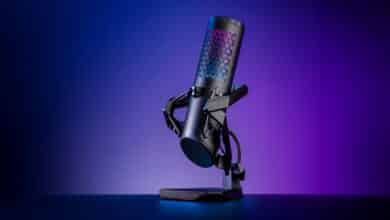
Podcasts, YouTube videos and other online productions have become more professional over the years. While at the beginning of the digital age, the Internet was dominated by videos produced in a dilettante manner, today even smaller hobby producers have switched to modern content that can be optimized in every conceivable way. Of course, today no one is satisfied with the recording quality of their integrated laptop microphone – which was not uncommon in the past. If you take a closer look at the YouTube landscape, you will find professional recording equipment in many places and notice that some microphones clearly dominate.
However, these microphones do not only have their professional quality in common. They also share an exorbitant price, which makes them anything but affordable for professionally oriented hobby video producers. In addition, they offer an almost unmanageable range of functions, which is necessary in the professional area, but hardly manageable for hobby users.
Blue, with the “Yeti” also very strongly represented in the market, reacted some time ago and presented with the “Yeti Nano*” a smaller, slimmed down version of the successful recording device. This smaller model should not only be cheap, but also easy to handle and very practical in everyday life.
We have subjected it to an extensive test and checked whether it can deliver what it promises. The results of this test will be presented below.
Design and workmanship
First of all, it is noticeable that the “Yeti Nano” is small. Anyone who knows the larger model will still be surprised – apart from the size, there are hardly any differences at first glance. Blue also relies on high-quality materials and first-class workmanship for the smaller Yeti. The USB microphone is supported by a metal stand with angle adjustment. In the test, this proves to be well adjustable and robust – it carries the microphone without any problems and ensures that it can be aligned without difficulty.

As already mentioned, Blue’s optical design is based on its own microphone, which it says is the best-selling in-house microphone. So it looks quite classic and discreet. The microphone has a central control that is illuminated by a small LED ring. In our opinion, this optical feature fits well with the overall picture of the microphone. The USB cable is attached to the bottom of the microphone. This is absolutely inconspicuous and disappears directly into the microphone holder – so there are no problems here.

The microphone is available in the colours “Shadow Grey”, “Vivid Blue”, “Red Onyx” and “Cubano Gold”.
All in all, the well-made microphone looks very high-quality. Blue therefore seems to attach importance to implementing the accustomed quality in this small and comparatively inexpensive model as well. Criticism regarding the design or workmanship cannot be found.

Recording Quality
Recording quality is probably the most important evaluation criterion. After all, a microphone should primarily produce recordings of acceptable quality – if this point is not given, it does not fulfil its purpose. If you know the bigger Yeti products, you should expect a lot from this new microphone. The following lines clarify whether the expectations can be fulfilled.

First it can be said that the “Yeti Nano” offers two different recording modes. In addition to the cardioid characteristic mode, an omnidirectional mode is also available. The cardioid characteristic is particularly suitable for formats in which only one speaker is present. Whoever records a podcast or vocals, runs game streaming or operates voiceover applications should therefore use this recording mode. In omnidirectional mode, all sound sources around the microphone are recorded. This mode is therefore particularly suitable for conference calls with several persons present or for podcast interviews with several interlocutors. Both recording modes work very well in the test. In kidney mode, in fact, only the sounds coming from the front to the microphone are recorded, while in omnidirectional mode, sounds from all directions are captured. The user can therefore be very satisfied with these two modes. The microphone supports 24-bit recording. These should ensure a professional production value.
We can see in the test that the sound quality is extremely good. It exceeds the expectations that are generally placed on a cheap recording device. In this way, professional recordings can actually be made that more than meet the demands of today’s world.
A particularly positive aspect is that no interference noise is generated by the speech. No special position needs to be taken when speaking in: For example, it is not necessary to speak into the microphone from above. In this way, the frequently occurring disturbing noises are avoided. This freedom is achieved with regard to the speech position and thus also the freedom from speech-induced noise through the very well functioning kidney mode of the microphone.
So we are more than satisfied with the recording quality. Here, too, Blue’s “Yeti Nano” shows no weaknesses.
Size, Functional Range and Operability
As already mentioned at the beginning, the “Yeti Nano” is comparatively small. In the test, of course, we not only examined how big it was, but also the advantages and disadvantages that resulted from it. For example, we have found that its small size makes it very suitable for the usual workplace of a hobby video producer. It requires considerably less space than the large Yeti version and can be placed quickly. In addition, it is suitable for travel. For example, if you want to record an interview during an event, you can take your Yeti nano microphone with you without any space problems.

At this point, however, the first major disadvantage of the tested device must be addressed: Unlike the Yeti, it does not offer a bidirectional mode. This mode is painfully missed especially in interviews with only one other interviewee. The user of the “Yeti Nano” then has to use the omnidirectional mode, which not only captures noise from two directions, but from four – and thus picks up all kinds of noise that would be avoided in bidirectional mode. The bidirectional mode could also be used particularly well on the road, as this often leads to two-way interviews in which the usually high noise level is to be suppressed. Here the “Yeti Nano” weakens and is not the best choice. A stereo mode, which is available with the normal Yeti microphone, is also missing here.
The “Yeti Nano” offers a latency-free headphone output. In fact, the sound transmitted here proves to be free of interference and, above all, delay, which is a great advantage.
The microphone is controlled via a volume, directional and mute control. It is also possible to make these settings in an app. This app will be examined in more detail in the next point.
Setting Options/App
As already mentioned, all settings can be made on a control located directly on the microphone. In addition, however, it is also possible to make all settings in the Sherpa Companion app, also developed by Blue and included in the scope of delivery.
Ultimately, this app proves to be of little use. She had us install a firmware update, but afterwards the microphone was no longer installed by the app. Normally you should be able to make all important settings here.
Conclusion of the Blue Yeti Nano Review
The recommended retail price of the recording device is 120 Euro (currently: € 119.99 *). For this price, the user receives a device that is not only of high quality, but also offers everything a hobby video producer needs. With Blue’s “Yeti Nano”, podcasters, musicians and game streamers have the opportunity to record their content in professional quality. In our test, the microphone showed itself to be very strong, especially in terms of recording quality. In addition, the model is easy to handle and easy to operate via a controller and an app. So it’s worth its price in any case. Only the absence of the bidirectional mode could be negative in some situations.
Blue Yeti Nano
Workmanship
Recording
Features
Value for Money
An affordable, handy microphone with professional recording quality.







